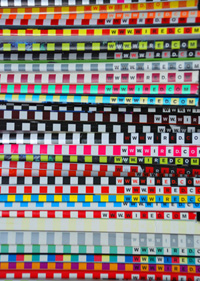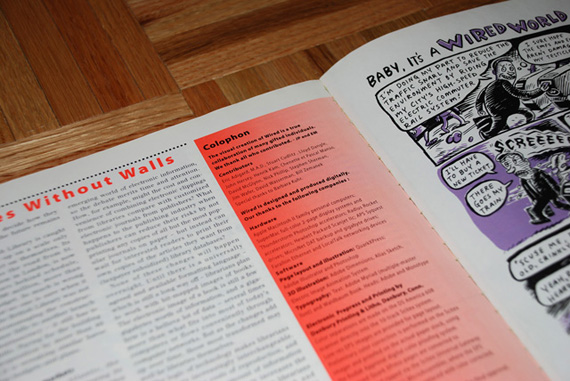Wired 1.1: An Archaeology
Wired magazine turns 15 years old this month. This column looks back at the very first issue.

Peeling back those matte pages now, one can't help falling victim to a bit of nostalgia for this town crier of the proto-digital era. There was no logical reason that this magazine should even have existed in 1993. Clinton/Gore had just been sworn in, and no one was talking about the "Information Superhighway" yet. Words like baud and Usenet and ISDN hadn't even been surrendered to the dustbin of digital history.
Need more historical perspective? There weren't even any URLs in the first issues of Wired! The World Wide Web barely existed, and there was no Mosaic browser on which to view it anyway. Goatse wasn't even a dirty thought yet.
And yet there it was, the premiere issue: that blocky logo and Bruce Sterling peering out from the cover. For a brief moment, it seemed as though the nerds were about to take over the world... right up until the suits showed up a few years later to pummel them with their briefcases of money.
But we're getting ahead of ourselves in this story. Let's take a look at that first issue, piece by piece.

Staff Box
Started by Louis Rossetto and Jane Metcalfe, who moved to California from Holland in 1991, Wired opened with a staff box of unknowns, at least to the traditional media world. Many of them would become the most important technology writers of the next decade.

Kevin Kelly, the founding executive editor, came from the Whole Earth Catalog and the WELL. John Battelle, who would later found Federated Media and write the definitive book on Google, was the managing editor. The rest of the staff box was sprinkled with names that are now recognized as tech pundits of various stripes: Howard Rheingold, Bruce Sterling, Stewart Brand, John Markoff, Michael Wolff, and Nicholas Negroponte. And of course, the "Patron Saint," Marshall McLuhan.
(An aside: it's difficult to remember how McLuhan was perceived pre-Wired. Though certainly a revered scholar in his lifetime [let us not forget Annie Hall], I also seem to recall a huckster backlash around this time. But three years after the premiere issue of Wired, McLuhan was on the cover of the magazine. Today, even his worst theories get roundly quoted, especially by blowhards like me.)
Tired / Wired
Magazine editors tend to hyperbolize their craft, and nothing gets deliberated with more over-analysis than the opening pages of a magazine. The conventional wisdom is that the blurby, picture-filled front pages set the philosophical agenda of a magazine. The "front of the book," as they call it, psychologically defines who should be reading this rag by persuading you to join the club of similarly excellent tastemakers. So the Wired/Tired Index probably seemed like a stroke of genius. It was the perfect way to divide the world into two simple categories of people: There are those who are wired -- they get it! And there are those are tired -- they don't!
It's classic hippie logic. And congratulations! Because you're reading Wired, you're in the right category.
In retrospect, it's unclear which side of this great divide the actual editors themselves fell on. On its maiden voyage, Wired deemed Nintendo a tired entity, while the long-forgotten gaming console 3DO was celebrated as wired. And for mysterious reasons, painting (painting?) crept into wired status, while performance (performance?) was strangely shelved as tired. But the clincher certainly had to be declaring REM (who had just released their best album, Automatic for the People) tired, but passing wired status onto midwest alt-country act The Jayhawks. This is akin to saying that Graham Parsons was a great DJ.
Other front-of-the-book items: a preview of a cult film called Jurassic Park, a review of a print zine called bOING bOING, and a report on a crazy new technology that could free up your cable tv lines for phone calls.
FeaturesFor all the peculiar editorial choices in the early issues of Wired, the strangest must certainly be giving Camille Paglia license to talk about Marshall McLuhan.

But the editors actually turned this stagnant interview into something a little funny by reprinting Paglia's handwritten edits scrawled over the top. From the first issue, one could already foresee that Wired was going to be a good publication, but this bit of whimsy suggested that it might just go beyond being the next Mondo 2000. This brand of self-awareness only comes along in decade-long chunks: a '60s Rolling Stone, a '70s Esquire, an '80s Spy.
Or it was just a dumb prank. Whatever.
The cover story, penned by Bruce Sterling, is one in a long history of virtual war stories that Wired would publish. It forgoes references to Ender's Game, but doesn't leave out video game comparisons. "It's modern Nintendo training for modern Nintendo war." Considering that the page directly preceding this is an ad for a new book called The Windows 3.1 Bible, it seems difficult to image how revolutionary these virtual war games could have been.
But what the other features portend has become a Wired hallmark: the clash between culture and technology. John Markoff's story on cellphone hacking dissects a digital subculture in a way that would be replicated several times in the proceeding decade. Similarly, the Otaku feature was prescient in its analysis of Japanese society before it had become a Western obsession. And an interesting note: the story on Richard Stallman's obstacles toward free software doesn't include the phrase "open source" because it had yet to even be popularized.
The Ads
Here's the prevailing question when persuing the ads in this issue: were they as unintelligible then as they are now? The two companies that bought this issue's very first ad and very last ad -- Origin and Trans Rebo, respectively -- were probably as unknown then as they are now. And it's unlikely that the 100,000 copies that the first issue of Wired sold on the newsstand helped them in any way.

A few pages in, the most emblematic page of the first issue of Wired appears.

He looks like an old John "I'm a PC" Hodgman! And look closely -- that screen really says "Fax Transmittal."

Oh, to be young again.

Design
Early Wired is often remembered for its edgy design aesthetic. The disillusion of this myth that you will feel in looking back at the first issues of Wired is comparable to when MTV replays those once-edgy Pat Benatar videos.

The Negroponte Index
MIT scholar, Wired investor, and OLPC creator -- Nicholas Negroponte is himself something of a patron saint to the digerati. But he's clearly crummy at making predictions.
In his inaugural back-page column, Negroponte takes on the emerging technology known as High-Definition Television. With the goggles of a decade-and-a-half to look through, the opening line hits you like a DeLorean hurled from the past: "High-definition television is clearly irrelevant."
Negroponte contends that the future will actually be fuzzy, arguing that it's a mistake to believe "achieving increased image quality is the relevant course to be pursuing." As anyone who's pored over debates about 1080 vs. 720 and counts their HDMI jacks like their children, this looks like the crazy ramblings of a fuzzy-headed college professor.
To be fair, the futurist gets it half right, such as when he prognosticates a burgeoning on-demand culture but mistakingly fetishizing perspective viewing:
What is needed is innovation in programming, new kinds of delivery, and personalization of content. All of this can be derived from being digital. The six-o'clock news can be not only delivered when you want it, but it also can be edited for you and randomly accessed by you. If the viewer wants an old Humphrey Bogart movie at 8:17 pm, the telephone company will provide it over its twisted-pair copper lines. Eventually, when you watch a baseball game, you will be able to do so from any seat in the stadium or, for that matter, from the perspective of the baseball. That would be a big change.
Sounds awesome! Too bad approximately 1 kjillion dollar were spent last year on cramming living rooms with big ass TVs instead.
Colophon
I remember exactly where I was when the first issue of Wired was handed to me. Exiting a coffee shop called The Urban Stampede -- the only coffee shop within 70 miles of the small midwest state school I was attending -- a friend accosted me, clutching a mysterious magazine with a striped spine. He shoved it in my hands, exasperated, "You have to see this." Wired instantly became required reading for all of our friends.
And our favorite part of the magazine was buried in the back, in the pages that articles jumped to: the colophon.

There were probably two reasons why we loved the colophon: 1) we had no idea what a colophon was, and 2) it showed the means of production of the magazine. The colophon listed the computers (Apple Macintosh II), the printers (HP Scanjet IIc), the layout software (Quark XPress), and even the routers (Farallon). And then it concluded with some music (Dinosaur Jr., Curve, k.d. lang, etc.) and a final heading for "drugs of choice" (caffeine, sugar, Advil).
It sounds corny, but we loved this magazine because its creators drank the same soda as us. These people actually had opinions about routers and ethernet cables!
I don't know if this is surreal or predictable, but it's certainly obvious now: futurism and nostalgia are intricately linked with each other. Revisiting the early pages of Wired reminds one of a time when there was an underground culture -- when not everything was known by everyone else. Can you remember a time when there were secrets? It sounds so naive.
But it also sounds tremendously boring. Thankfully, we'll always have the future.

